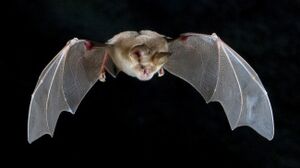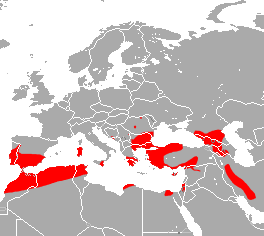Mehely's horseshoe bat facts for kids
Quick facts for kids Mehely's horseshoe bat |
|
|---|---|
 |
|
| Conservation status | |
| Scientific classification | |
| Genus: |
Rhinolophus
|
| Species: |
mehelyi
|
 |
|
| Mehely's horseshoe bat range | |
The Mehely's horseshoe bat (Rhinolophus mehelyi) is a special kind of bat. It eats insects and belongs to the Rhinolophidae family. You can find these bats in Southern Europe and parts of the Middle East. They live in a narrow area around the Mediterranean Sea. This includes places from North-Western Africa, across Portugal, Spain, and islands like the Balearics, Sardinia, and Sicily. They also live in southern France, the Balkan Peninsula, and parts of Asia Minor.
Contents
What Does It Look Like?
This bat is a medium-sized member of the Rhinolophus group. It has pale lips and grey-brown ears. Its wings, which are also called flight membranes, are also grey-brown. The fur on its body is quite thick. The bottom part of each hair is grey-white. The fur on its belly is almost white. The fur on its back is grey-brown. You can see a clear line where the belly fur meets the back fur.
Where Does It Live?
Mehely's horseshoe bats love to live in caves. They especially like caves made of limestone that have water nearby. Sometimes, they share their cave homes with other bats. These can include the lesser horseshoe bat (Rhinolophus hipposideros). They also share with the greater mouse-eared bat (Myotis myotis) and the common bent-wing bat (Miniopterus schreibersi). They prefer to roost, or hang out, in warmer parts of the cave. For example, in the Cova de Sa Guitarreta in Mallorca, they hang freely from the cave roof.
How It Finds Food
These bats come out at dusk, which is when the sun sets. They fly low over the ground to hunt. They like warm hillsides and also hunt among bushes and trees. Their main food is moths and other insects.
Amazing Echolocation
Mehely's horseshoe bats use a special skill called echolocation. This helps them "see" in the dark using sound. They make a constant, high-pitched sound. This sound is usually between 105 and 112 kilohertz (kHz). At the very end of the sound, the frequency drops a little. Each sound signal lasts for about 20 to 30 milliseconds. The sounds they make can sometimes be similar to those of the lesser horseshoe bat and the Mediterranean horseshoe bat.
Reproduction
Scientists have studied how Mehely's horseshoe bats choose their mates. A study in 2014 showed that the sounds male and female bats make tell a lot about their size and health. Larger male bats made calls with higher frequencies. These calls attracted females twice as often as males with lower frequency calls. However, male bats seemed to choose females randomly. This suggests that female bats pick males based on their call frequency. They do this because it might mean their babies will be healthier and stronger. This way of choosing a mate is similar to a "lek" system. It means that female choice helps shape how male call frequencies have changed over time.


